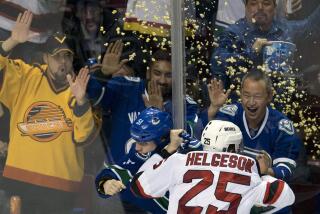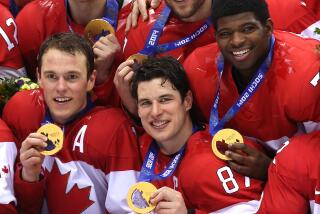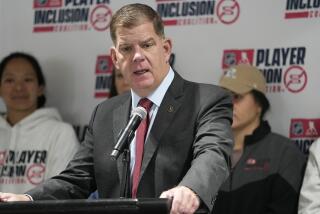NHL concerned over head count
Keith Primeau has not put on his full hockey equipment since the day he retired from professional hockey, a career cut short by several concussions, not all of them documented.
To say he has good days would be stretching the definition.
“I can honestly say here that there isn’t a day that goes by that I don’t sense I’ve damaged my brain,” said Primeau, who retired in 2005 at 34. “Whether I stand up and get a headache or I’m resting and I get a headache, I know exactly why I had to stop playing.”
The former Philadelphia Flyers star has made it his post-career crusade to teach people about concussions. Primeau suffered at least four in his career, and if his own lingering symptoms weren’t enough motivation, three of his four children have suffered documented concussions through their sporting activities.
Teaching moments, unfortunately, have been many in the NHL in 2011.
Concussion was the dominant word in the NHL last year and all but impossible to ignore, especially with the face of the league, Sidney Crosby, again indefinitely sidelined. Players famed for their ability to push pain aside have been sidelined in alarming numbers by head injuries this season. Players are bigger, faster and stronger, but the old “tape-an-aspirin–to-it-and-get-back-in-there” mentality has been replaced by a greater awareness of concussions and their potential damage.
Still, the question arises seemingly almost every morning after news of more head injuries: Is the NHL doing enough to protect its players?
On one front, the NHL has moved to impose stiffer penalties for head hits, as well requiring stricter rule enforcement on the ice. In the summer, the league modified language regarding two key rules — Rule 41 (boarding) and Rule 48 (illegal check to the head) — implementing changes to improve player safety.
Also, as part of a transition in leadership, the NHL launched a department of player safety and put future Hall of Famer Brendan Shanahan in charge this season. Shanahan not only issues written rulings in terms of supplementary discipline after illegal hits, but also makes a video presentation, showing the incident and the rationale for the decision.
The decisions are on the NHL’s website almost immediately and available through Shanahan’s Twitter feed. Additionally, Shanahan has been visible in terms of continuing player education, releasing video highlights of what constitutes a legal check and illegal actions.
“My impression of the league is that they’re very proactive on addressing any issue that comes up with respect to player safety,” Vancouver Canucks President and General Manager Mike Gillis said. “I know the meetings I’ve been at the last three years we spend an inordinate amount of time looking at checks, looking at how players are getting hit, trying to understand how these injuries are occurring.”
Last season, protocols were put in place to keep athletes on the sideline at least a week after suffering a concussion. Under these guidelines, players deemed to have suffered a head injury must leave the game immediately and be observed in a “quiet room” by physicians attending the game. It isn’t always a popular rule — coaches hate to lose key players in the midst of a game, and the players themselves are not always eager to go either. But it is one step.
Before joining the Canucks, Gillis was a well-known player agent, representing former players Pavel Bure and goalie Mike Richter, among others. Richter was forced to retire in 2003 because of concussions.
Now, on the management side, Gillis said that there was a great concern when one of his players suffered a concussion last season. Although the player said he felt fine within an hour after the injury, the Canucks followed the league-mandated protocol.
Other leagues are also addressing the issue. The NBA this season has implemented guidelines that will determine when players return from head injuries. If a player is diagnosed with a concussion, he must complete a series of steps to confirm that he’s healthy enough for competition.
The NFL recently imposed more stringent concussion rules, but also included other modifications to protect quarterbacks. When there is suspicion of a concussion for any player, he must pass a battery of tests and be symptom-free before being allowed to return to the game. If not cleared, he must be examined and cleared by an independent doctor in order to return to practice.
Concussions have always been a hazard of hockey, but the number of high-profile players who have become victims has sparked intense debate over what the league can do.
The issue has deeper resonance considering Jan. 1 is the one-year anniversary of Crosby’s head injury. Nothing has been quite the same for the Penguins star since that drizzly night at Heinz Field in Pittsburgh when he incurred a head hit from the Washington Capitals’ David Steckel in the Winter Classic.
That, combined with another blow four days later, kept Crosby out of action until Nov. 10 of this season. The glow of Crosby’s triumphant return did not even last a month as he was shut down again when he started suffering another round of concussion-like symptoms after a Dec. 5 game against Boston when he collided with a teammate.
“I don’t think ‘frustrating’ even describes it.” Crosby recently told reporters in Pittsburgh. “You have to listen to your body.”
There was not much information coming from the Pittsburgh camp about Crosby until Penguins Coach Dan Bylsma revealed Wednesday that Crosby still has “some symptoms.”
The company Crosby is keeping on the list of the concussed is filled with the biggest names in the NHL. You could put together a Stanley Cup championship team or Olympic gold medal-winning squad with the injured players.
At one end, there is the fresh-faced Jeff Skinner of the Carolina Hurricanes, who won’t turn 20 until May 16. At the other is 37-year-old Chris Pronger of the Flyers, who has been ruled out for the rest of the season and whose playing future is in doubt.
Minnesota’s Pierre-Marc Bouchard missed more than 100 games before he returned, and the St. Louis Blues’ David Perron missed 97. He came back Dec. 3 and has recorded 10 points in his first 10 games. The career of the Bruins’ Marc Savard has spiraled downward since a crushing hit in March 2010 from Matt Cooke, and he probably will have to retire.
The league started collecting concussion data in 1997, with the formation of the Concussion Working Group, and the average number of concussions was around 80 a year from 1997 to 2004.
Since then, the first five years after the lockout were similar in terms of average number. Last season, the league saw “a spike” amid heightened awareness and education, a spokesperson said. The league has not been releasing definitive numbers regarding concussions.
“We have, in the last couple of years, decided to move away from giving absolute numbers, but I can tell you we’re basically, precisely flat, like where we were last year,” said Bill Daly, the NHL’s deputy commissioner. “I’ll acknowledge I think we’re one concussion ahead in the same number of games. So there’s been no spike in concussions this year, but it continues to be a number that’s higher than we’d like it to be.”
Daly made these comments to The Times in an interview just before the short Christmas break. Another sequence of concussion-related events occurred on the first two days after the break.
Nashville defenseman Shea Weber missed the Predators’ game Monday against Detroit because of a concussion. Toronto defenseman John-Michael Liles was put on injured reserve with concussion-like symptoms on Tuesday, as was Kings left wing Simon Gagne, having suffered a concussion in Monday’s victory against the Coyotes.
The rapid-fire sequence of new injuries caused prominent player agent Allan Walsh to tweet Tuesday morning, “Remember folks, ‘No crisis, no epidemic.’ ”
Walsh, of the management agency Octagon, and league officials are in sharp disagreement over whether the concussion issue has become an “epidemic.” Similarly, they do not share common ground on another hot-button issue, chronic traumatic encephalopathy. CTE is the neurodegenerative disease caused by repeated brain trauma and long connected to boxing.
The long-term effects of concussions are a key area of concern, which is why researchers from Boston University are studying brains of athletes, starting with Reggie Fleming, a former enforcer who died in 2009 and the first hockey player known to have CTE. Since then, athletes have been donating their brains to the study. More recently, researchers found a similar pattern with Bob Probert, who died of a heart attack at age 45, and was showing signs of CTE.
The research took another turn when vaunted goal scorer Rick Martin, who died in March of a heart attack at age 59, was found to have the same disease. Martin was part of the Sabres’ famed “French Connection” line.
“Rick Martin’s case shows us that even hockey players who don’t engage in fighting are at risk for CTE, likely because of the repetitive brain trauma players receive throughout their career,” said Chris Nowinski, co-director Boston University Center for the Study of Traumatic Encephalopathy.
NHL Commissioner Gary Bettman said earlier this month, after the league’s Board of Governors meeting in Pebble Beach, that data drawing a link between concussions and CTE was not conclusive.
Five brain samples might be a limited data pool, and though it might not be conclusive, it has struck a convincing note in some quarters.
“CTE is five for five,” Walsh said. “When Bettman says there’s no definite proof that there is a link between concussions and CTE, I think that statement will not hold the test of time, and once science catches up with the issue, Bettman is going to be on the wrong side of the science.
“It reminds me very much of tobacco executives in the ‘70s screaming to the media and testifying before Congress that there is no definitive link between cigarette smoking and cancer.”
Primeau has taken a leading role in promoting safety through his foundation stopconcussions.com. Two years into his retirement, he felt he needed to move front and center.
“On reflection, I said, how do we make a difference?” Primeau said. “We make a difference by making people aware, educate people and also through research and development.
“You can never understand until you’ve gone through it, how difficult it is on a daily basis to wake up with symptoms that are related to injury to the head. It’s not sports-centric. It’s cultural. We see brain injury all the time.”
About two-thirds of the teams in the league have had a player sidelined at some point this season with concussion symptoms. Some, like the Kings’ Mike Richards (this season) and Drew Doughty (last season) are reluctant to call it that.
The league permits teams to be as precise or vague as they want in publicly disclosing injuries.
As a result, the term “upper-body injury” can cover a lot of different ailments. Gillis said that it is done for the protection of the player.
“We’ve been talking a lot about what the effects are of disclosure and of people knowing about it and people asking a player, particularly in Vancouver,” the Canucks’ Gillis said. “Our players are famous in that city … if they have concussion symptoms they are constantly being asked and asked about it.
“There is some school of thought that it makes it worse for them because they are more susceptible to depression and stress and anxiety about it. It’s a challenging issue.”
Said Daly: “What the clubs are obligated to report to the media is not consistent with what they’re obligated to report to us. I’m very comfortable with the concussion numbers we get from the team medical professionals.”
Daly spoke about the changes the league has made on several fronts, talking about “softer glass environments,” and the changes in Rules 48 and 41, and stiffer stances in terms of supplementary discipline. “So I think we’ve been very, very proactive in this area and will continue to be going forward,” he said.
Gillis believes the next step is to look at equipment to try to minimize the impact of incidental contact “as much as possible.”
Walsh maintains the greatest push will come from a venue outside the sporting arena, taking note of the many lawsuits filed in the last few months by former NFL players against their league over concussions. He predicted the same thing would eventually happen in hockey.
“Mark my words, lawsuits are coming,” he said. “And there will be no greater change agent for the NHL and teams than lawsuits.”
twitter.com/reallisa
Staff writer Helene Elliott contributed to this report.
More to Read
Go beyond the scoreboard
Get the latest on L.A.'s teams in the daily Sports Report newsletter.
You may occasionally receive promotional content from the Los Angeles Times.











